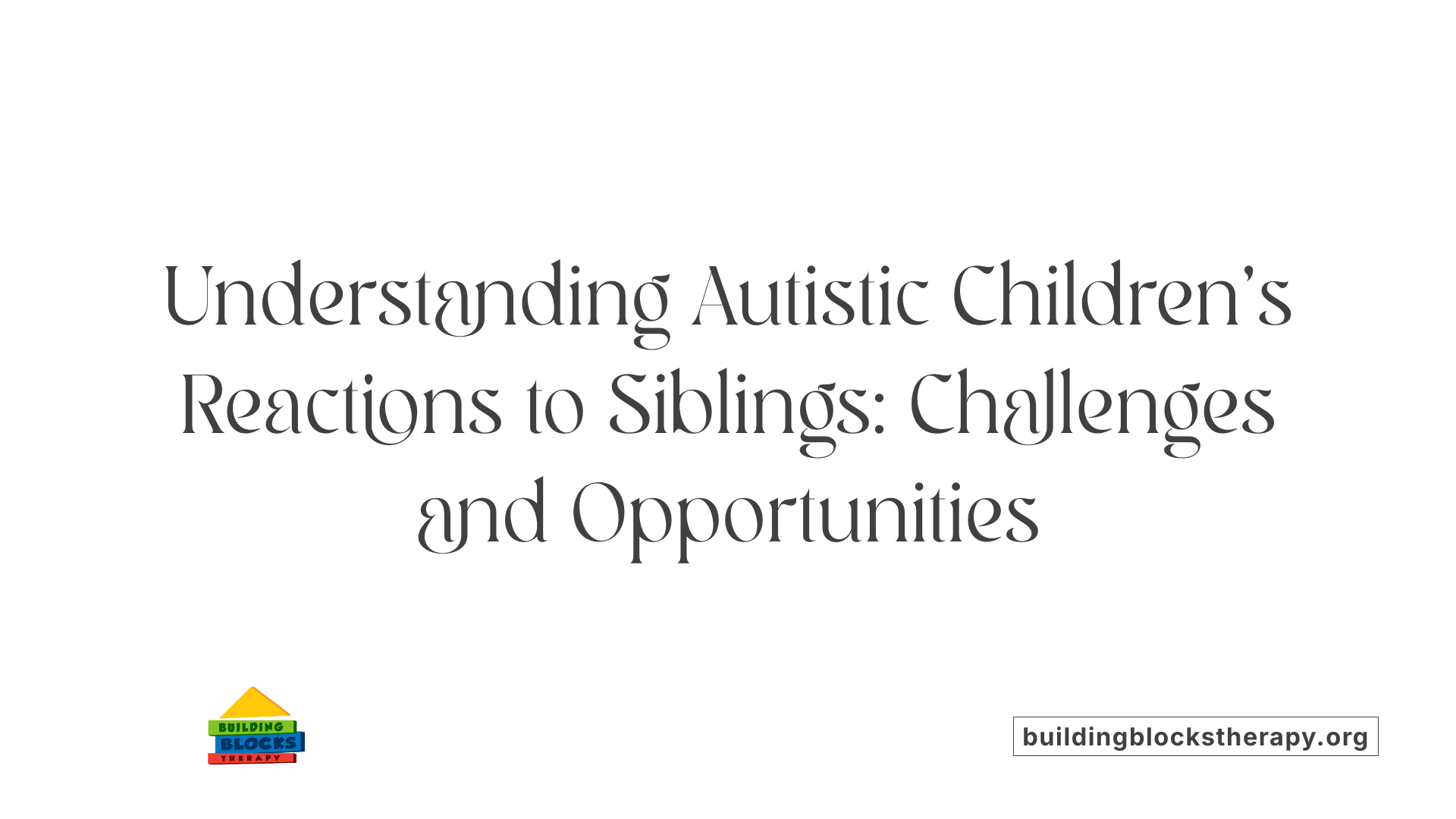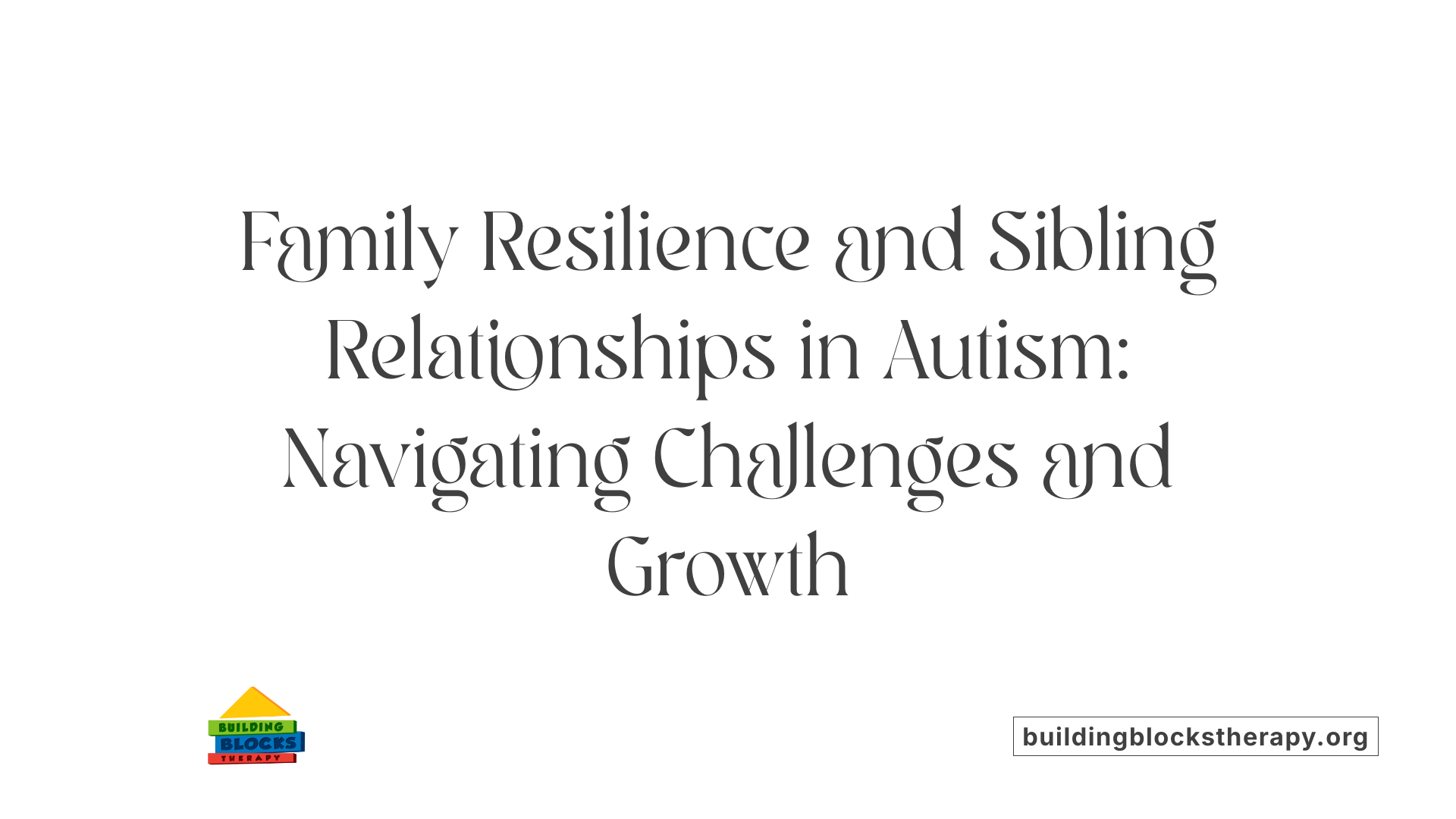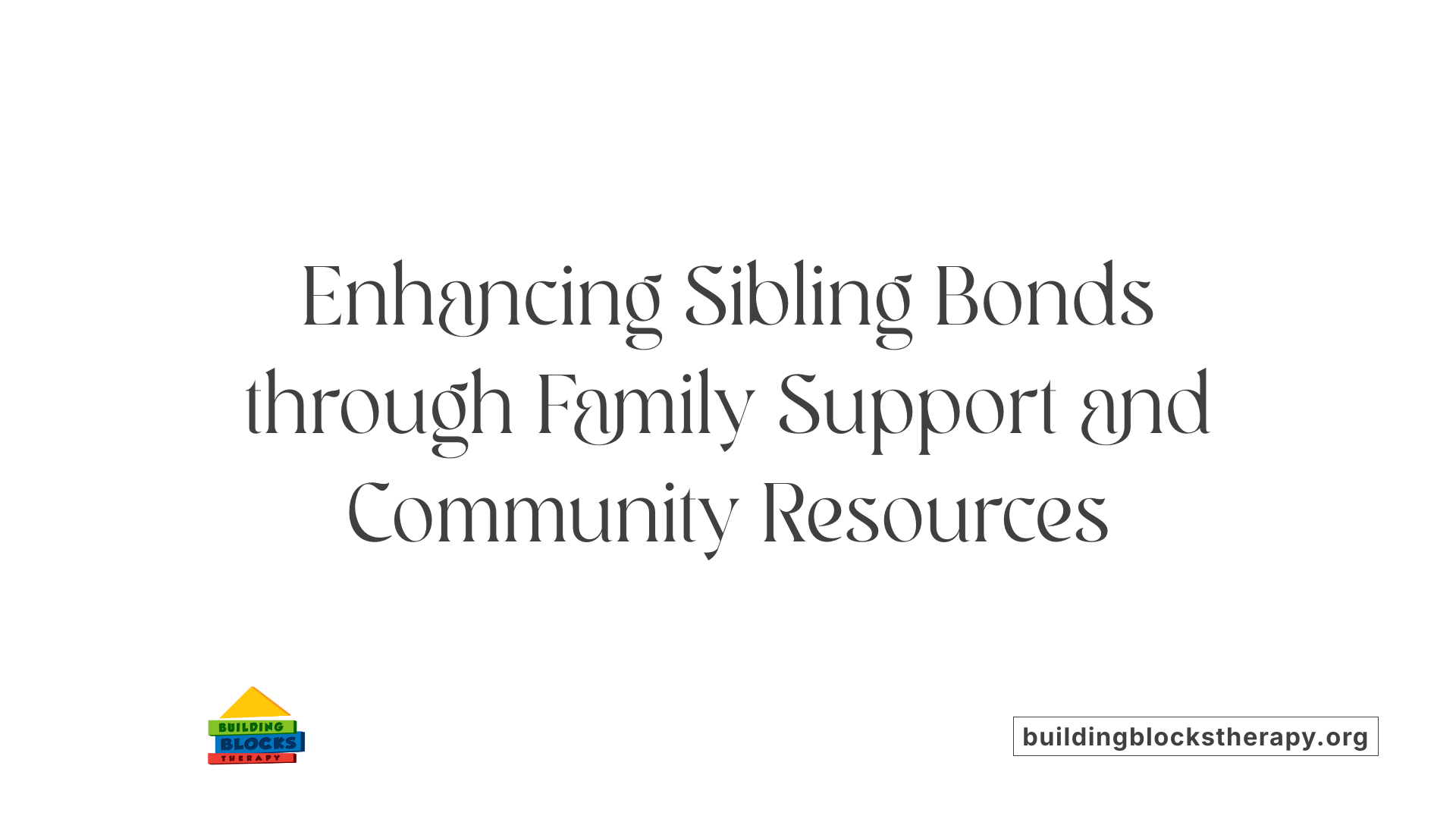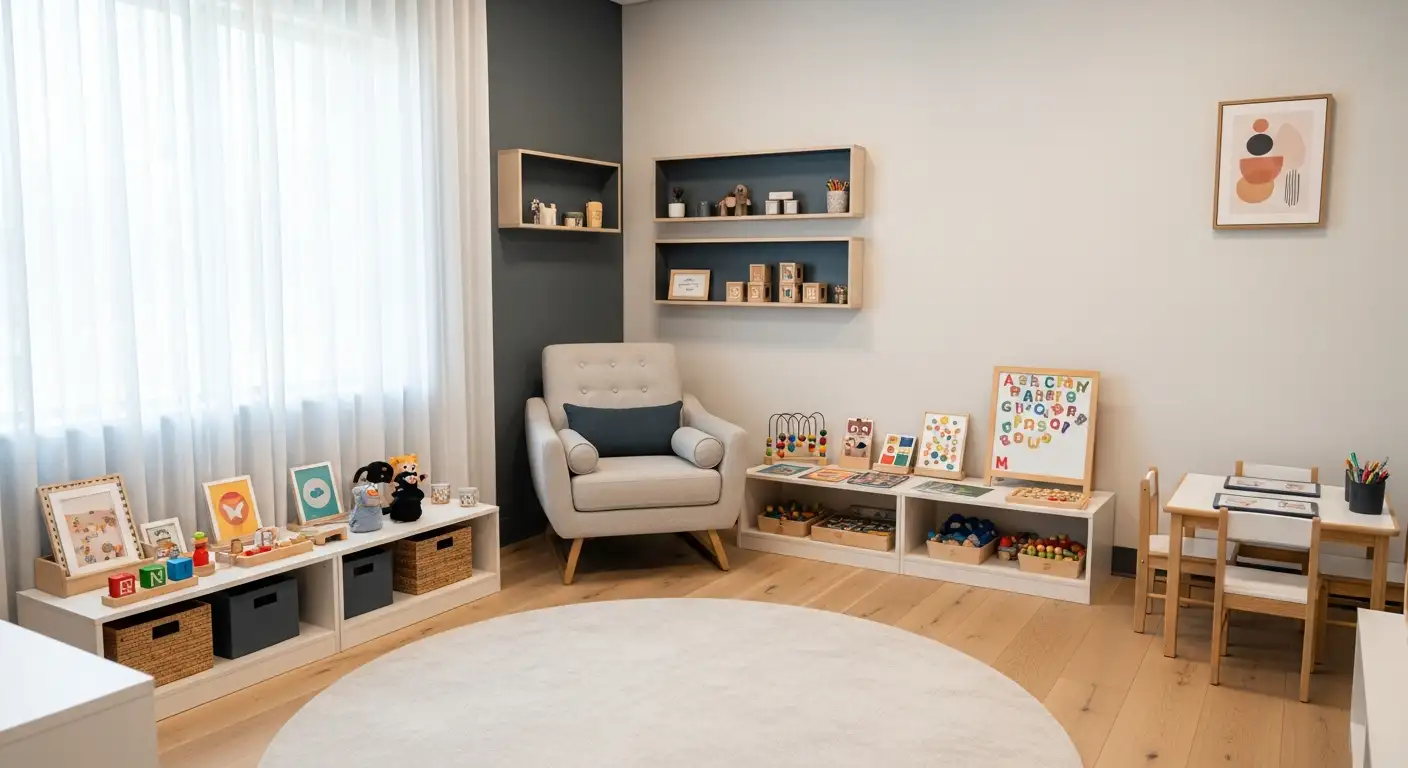Understanding the Complex Role of Siblings in Autism Families
Sibling relationships in families with children on the autism spectrum hold a profound influence on emotional, social, and developmental outcomes. While these bonds can foster remarkable resilience, empathy, and maturity, they can also present challenges such as emotional stress, misunderstandings, and shifts in family dynamics. This comprehensive examination explores how siblings of children with autism navigate their roles, what supports enhance their well-being, and how these relationships shape the journey of the entire family.
Developmental and Emotional Responses of Autistic Children to a New Sibling

What are common reactions of autistic children to a new sibling?
Autistic children’s responses to the arrival of a new sibling can vary greatly. Some may experience increased stress due to heightened sensitivities to sensory stimuli such as sounds, sights, or smells associated with the new baby. These sensitivities can lead to feelings of overwhelm or anxiety.
Additionally, changes in routines and family dynamics may trigger feelings of confusion or frustration. Many autistic children display signs of emotional processing challenges, including difficulty expressing their feelings or understanding social cues related to the new family member.
It’s common for autistic children to initially react with signs of distress like irritability, withdrawal, or even aggression. Some may need time to adjust as they seek familiarity and reassurance.
However, with appropriate support, they can develop positive bonds with their new sibling over time. Recognizing these varied reactions is the first step in providing the needed support and understanding.
Strategies to support autistic children during sibling introduction
Supporting an autistic child when a new sibling arrives requires patience and tailored strategies. Establishing a predictable routine helps create a sense of safety and control. Using social stories and visual aids can help prepare the child for upcoming changes.
Gradual introduction strategies—such as short visits or supervised meetings—allow the autistic child to get accustomed to the new sibling at their own pace. Involving the autistic child in preparatory activities, like selecting gifts or helping with small tasks, fosters inclusion and a sense of involvement.
Reassurance and positive reinforcement are essential. Celebrating small milestones in bonding, such as a shared smile or gentle interaction, can build confidence.
Furthermore, keeping the environment calm and minimizing sensory overloads during initial interactions helps reduce stress. When challenges arise, seeking guidance from professionals like therapists or counselors can provide additional support tailored to the child’s needs.
Role of routines, visual aids, and involvement
Maintaining familiar routines is crucial for autistic children to feel secure during family changes. Consistent schedules for meals, play, and rest help reduce anxiety.
Visual aids—like picture schedules or social stories—can clarify what to expect and guide behaviors during the transition period. These tools help autistic children understand and process new social roles and family dynamics.
Involving the autistic child in family activities related to the new sibling, such as preparing the nursery or choosing clothes, can build a sense of participation and control.
Creating opportunities for positive interactions—like shared activities or reading about new siblings—encourages emotional bonding. Encouraging patience and understanding from family members further supports a smooth transition.
In summary, recognizing the unique reactions of autistic children to a new sibling and proactively applying supportive strategies—through routines, visual aids, and involvement—can foster a nurturing environment that promotes emotional well-being and positive relationships.
Supporting Typical Siblings: Strategies, Needs, and Resources

What are effective strategies for supporting siblings of children with autism?
Supporting siblings of children with autism requires a combination of education, emotional support, and opportunities for positive engagement. One effective approach is providing age-appropriate information about autism. For example, resources like the 'Sibling's Guide to Autism' help siblings understand their brother or sister’s behaviors, reducing confusion and fostering empathy.
Validating siblings’ feelings is equally important. Parents should acknowledge emotions like jealousy, frustration, or sadness, and encourage open conversations about these feelings.
Involving siblings in family planning and decision-making reinforces their sense of inclusion and control. Family activities that promote bonding can help strengthen relationships. Programs such as Sibshops or other sibling support initiatives create safe spaces where siblings share experiences and connect with peers going through similar situations.
Offering continuous emotional support and reassurance can help siblings cope with challenges and mitigate feelings of neglect or resentment. Caregivers should also prioritize their own well-being to sustain positive family dynamics.
Finally, seeking out support services, advocacy tools, and training enhances the family’s ability to address challenges holistically, ensuring that siblings’ needs are not overlooked and fostering resilience within the family.
What support options and educational resources are available for non-autistic siblings?
Non-autistic siblings have access to various support options and educational tools designed to help manage their unique emotional and social needs. Support groups such as the Sibling Support Project, UCP Sibshop, and The Arc of Lancaster Lebanon Sibshop provide peer support networks, allowing siblings to share experiences and learn from others facing similar challenges.
Educational resources like books—including titles like 'I Love My Brother!', 'And Don’t Bring Jeremy', 'Living with a Brother or Sister with Special Needs', and 'The Sibling Slam Book'—offer insights into the emotional landscape of living with a sibling who has autism. These materials help siblings understand their feelings, promote empathy, and teach positive interaction skills.
Professional support, including counseling or family therapy, is also vital. Therapy can address feelings of anxiety, depression, or internalizing problems that are more prevalent among siblings of children with autism. Utilizing these resources collectively fosters understanding, emotional resilience, and stronger sibling bonds.
Genetic Factors and the Hereditability of Autism Among Siblings
What is known about the genetic factors associated with autism and its transmission among siblings?
Research indicates that genetics play a dominant role in the development of autism spectrum disorder (ASD). It is estimated that approximately 80 to 90 percent of the risk for autism can be attributed to genetic factors. Siblings of children with autism tend to share a higher percentage of their genetic makeup, with about 66% sharing their father's genes and roughly 30% sharing their mother's, pointing towards a significant paternal influence.
Twin studies further highlight the genetic component, showing that identical twins (who share 100% of their DNA) have concordance rates of at least 70%, much higher than fraternal twins or siblings. This strong heritability suggests that multiple genes contribute to ASD, making it a polygenic disorder.
Additionally, around 20% of autism cases are linked to new genetic mutations, termed de novo mutations, which are not inherited from either parent but occur spontaneously.
While environmental influences may have minor effects, the primary pattern involves complex interactions among many genetic factors. The importance of paternal genetics has been consistently underlined in recent studies, emphasizing that inheritable genetic components from the father can significantly influence the likelihood of autism in siblings.
This genetic understanding helps explain why autism tends to run in families and highlights the need for ongoing research into specific genes and inheritance patterns that could lead to better prediction and early intervention strategies.
More info search query: Genetic transmission of autism among siblings and familial genetics
This knowledge underscores the complex genetics behind autism, illustrating the importance of family history and genetic counseling for families with a child on the spectrum.
Influence of Siblings on Developmental Trajectories in Autism
How does having an autistic sibling influence non-autistic children's emotional and social development?
Having a sibling with autism uniquely shapes the emotional and social growth of neurotypical children. Many develop qualities such as patience, empathy, and resilience through daily interactions with their autistic siblings. These experiences often enhance their emotional intelligence, teaching them how to cope with challenging situations and understand diverse behaviors.
However, this relationship can also present challenges. Siblings may experience elevated levels of stress, anxiety, or feelings of embarrassment, especially in social settings or when they sense family stress. Feelings of guilt or jealousy towards parental attention can also affect their emotional well-being. External factors like limited family resources and social support may exacerbate these issues.
The overall impact varies significantly based on individual family circumstances, perceptions, and available support networks. When families foster open communication and provide proper emotional guidance, siblings tend to exhibit increased empathy and maturity, turning their experiences into lifelong strengths.
What are the known benefits of sibling involvement for children with autism?
Research highlights numerous positive outcomes for children with autism who have involved siblings. These siblings often become important social partners, engaging in daily communication, shared activities, and meaningful friendship.
Such sibling interactions serve as informal social training, helping autistic children enhance their social-communication skills, interpret non-verbal cues, and develop a better understanding of others' perspectives, known as theory of mind.
Studies show that having siblings accelerates growth in adaptive behaviors from childhood into adulthood. This effect is especially pronounced in families with gender-matched siblings or when older siblings understand autism well and provide appropriate support.
Overall, sibling involvement fosters not only emotional and social development but also contributes to improved developmental outcomes for autistic children, benefiting both their social skills and resilience.
How do research findings reflect on adaptive behavior and growth?
Long-term research tracking individuals with autism indicates that sibling relationships have a significant influence on adaptive functioning trajectories. Those with siblings show faster progress in social, communication, and daily living skills over time.
For example, participants with siblings exhibited more rapid growth in adaptive behaviors across both childhood and adulthood. These gains were magnified in Black participants and in cases where the sibling was older or of the same gender, suggesting that shared experiences and sibling roles play crucial roles.
Furthermore, the presence of siblings was associated with building resilience and emotional strength, which are vital components for improved quality of life. These findings emphasize the importance of sibling relationships as a natural, ongoing support dynamic that positively shapes developmental pathways.
How do gender differences and age effects influence sibling relationships?
Age and gender significantly impact sibling experiences and developmental benefits. Older siblings tend to have a deeper understanding of autism as they mature, which can lead to more empathetic and supportive interactions.
Younger siblings might initially have limited understanding but develop more detailed knowledge as they grow, helping to reduce misconceptions or fears. Gender-matched siblings—such as brothers with brothers—often show the steepest growth in adaptive and social skills, highlighting the influence of shared gender-related experiences.
Age differences also influence relationship quality. Larger age gaps can mean less shared activity and emotional closeness, while smaller gaps often foster closer bonds. Despite these variations, consistent positive interactions, open communication, and family support can nurture strong, supportive sibling relationships that evolve beneficially over time.
| Aspect | Impact | Additional Details |
|---|---|---|
| Emotional Development | Increased empathy, patience, resilience | More mature responses to social and emotional challenges |
| Social Skills | Improved social communication and understanding | Benefits in theory of mind and non-verbal cues |
| Growth Trajectory | Faster improvement in adaptive behaviors | Especially in gender-matched or older siblings |
| Gender Influence | Siblings of same gender show more growth | Facilitates shared experiences and understanding |
| Age Effects | Closer age gaps enhance bonds | More shared activities and emotional closeness |
Understanding these dynamics helps families and support systems tailor interventions that maximize sibling relationships' positive potential while acknowledging and addressing challenges.
Family Dynamics and Broader Impacts of Autism on Siblings and the Family Unit

How do sibling relationships affect children with autism and their families?
In families where a child has autism, sibling relationships hold significant influence over the emotional and social development of both the autistic child and their nondisabled siblings. These bonds are often marked by support, patience, and shared experiences that can foster resilience and social skills. When siblings are supportive and understanding, they contribute positively to their autistic sibling's growth, helping to promote emotional well-being and social competence.
However, these relationships can also be a source of stress if conflicts arise, or if feelings of jealousy, resentment, or neglect develop due to disproportionate attention towards the autistic sibling. Factors such as family environment, socioeconomic status, maternal mental health, and sibling age or gender can modulate these dynamics. Despite challenges, many nondisabled siblings demonstrate considerable maturity, developing qualities like empathy, patience, and problem-solving skills.
Interventions that aim to enhance sibling interactions—such as family counseling, support groups, and educational programs—can foster healthier relationships. These strategies not only improve sibling bonds but also strengthen overall family resilience. In turn, this holistic support benefits the development and adjustment of children with autism, creating a more harmonious family environment.
Research indicates that, although family stress may increase and some siblings experience developmental delays or emotional difficulties, many siblings adapt well and even develop positive traits that benefit their personal growth. Conversely, some may experience internalizing problems such as anxiety or depression, especially if their needs are overlooked.
Supporting siblings through open communication, honest explanations about autism, and opportunities for shared family activities can alleviate misunderstandings and emotional burdens. Such efforts contribute to better family cohesion, reducing conflict and fostering a nurturing environment where every member feels valued.
Effects of family stress and perceptions
Family stress levels tend to rise when a child has autism, largely due to concerns about future caregiving roles, behavioral challenges, and emotional strain. Parents' perceptions of their child's condition and their ability to manage daily routines influence sibling experiences significantly. Mothers often report less closeness and emotional involvement among siblings, highlighting the importance of addressing family dynamics proactively.
Open family communication, inclusive planning, and involving siblings in caregiving and decision-making processes can diminish stress and foster understanding. When families maintain a positive outlook and emphasize each child's unique contribution, sibling relationships and overall family functioning tend to improve.
Impact of sibling relationships on family cohesion
Strong, positive sibling relationships can serve as a stabilizing force within families impacted by autism. Siblings can act as emotional anchors, provide daily companionship, and help normalize routines. When relations are supportive, families report better adaptation and reduced overall stress.
Conversely, strained sibling interactions or perceived favoritism can lead to emotional distance, rivalry, and resentment. Providing siblings with individual attention, fair responsibilities, and inclusive family activities supports balanced relationships. Siblings often develop patience, tolerance, and compassion through these interactions, which enhances family bonds.
Future caregiving and family planning considerations
As families plan for the future, especially regarding parental aging and caregiving responsibilities, siblings often emerge as essential figures in ongoing support. Preparing siblings early—through education, open discussions, and involvement in care plans—can ease transitions and reduce anxiety about future responsibilities.
Siblings can serve as advocates, decision-makers, and emotional supports when adult care needs rise or parents can no longer provide full care. Facilitating conversations about health, finances, and legal matters ensures that these young caregivers are equipped and supported.
Long-term planning that recognizes sibling roles reduces uncertainties, promotes family stability, and helps maintain the well-being of all members. Family-centered approaches that prioritize communication, fair treatment, and emotional preparedness are vital to managing the broader impacts of autism on the family unit.
The Role of Family Support and Community Resources in Enhancing Sibling Relationships

Importance of open family communication
Open, honest dialogue within the family plays a crucial role in fostering healthy sibling relationships. Explaining autism in simple, age-appropriate language helps siblings understand their autistic brother or sister’s behaviors, reducing confusion and anxiety. By discussing feelings openly, siblings can express emotions like jealousy or frustration, which promotes emotional clarity and resilience. Encouraging shared activities and one-on-one time also strengthens bonds and helps siblings feel valued.
Community programs and peer support groups
Support groups such as the Sibling Support Project, UCP Sibshop, and The Arc of Lancaster Lebanon Sibshop offer siblings a space to connect, share experiences, and gain emotional support. These programs help children and adolescents realize they are not alone in their feelings, reducing isolation. Books like 'I Love My Brother!' and 'The Sibling Slam Book' provide helpful insights and emotional guidance for young siblings, encouraging patience, empathy, and understanding.
Role of professionals and advocacy
Professionals like psychologists, counselors, and healthcare providers can support siblings through tailored strategies that address emotional needs and develop social skills. Sibling involvement in Applied Behavior Analysis (ABA) therapy can improve communication, reduce problematic behaviors, and strengthen relationship dynamics. Advocates also help families navigate healthcare, educational support, and future planning, ensuring siblings’ needs are recognized and met.
| Support Area | Resources | Benefits |
|---|---|---|
| Family Support | Open communication, shared activities, counseling | Improves emotional coping and sibling bonds |
| Peer Groups | Sibling support groups, books | Reduces isolation, promotes empathy |
| Professional Help | Therapies like ABA, counseling | Addresses emotional needs, enhances social skills |
Conclusion: Embracing the Complexity of Sibling Relationships in Autism
Sibling relationships in families with children on the autism spectrum are multifaceted, encompassing both positive and challenging experiences. While siblings often develop empathy, patience, and resilience through their unique bonds, they may also face feelings of jealousy, frustration, and emotional stress. These dynamics highlight the importance of tailored support and open communication within families.
Providing age-appropriate information about autism, creating opportunities for shared activities, and ensuring fair treatment help foster healthy sibling relationships. Support resources like sibling groups, books, and professional counseling play vital roles in addressing emotional needs and promoting understanding.
Ongoing research continues to uncover how family support, social perceptions, and intervention strategies influence sibling wellbeing. Community programs and initiatives aim to strengthen these bonds and ensure that siblings are not overlooked in the support system. Recognizing the complexity of sibling experiences allows families and professionals to better nurture these relationships, ultimately improving quality of life for all involved.
Nurturing Family Bonds and Promoting Resilience
Understanding how sibling relationships impact children with autism and their families is vital for fostering supportive environments that promote emotional health, social development, and resilient family dynamics. Recognizing the unique challenges and strengths inherent in these relationships allows parents, caregivers, and professionals to implement targeted strategies—ranging from education and support groups to tailored family interventions. As ongoing research sheds light on the complex interplay of genetics, family dynamics, and individual development, communities are increasingly equipped to nurture bonds that foster understanding, patience, and compassion. Ultimately, embracing these relationships with openness and support can positively influence the life trajectories of all family members, creating a foundation of love and resilience that extends well beyond childhood.
References
- The Impact of Autism on Siblings - PAAutism.org
- Sibling perspectives on having a sibling diagnosed with autism
- The Quality of Life among Siblings of Autistic Individuals: A Scoping ...
- Siblings Perspectives: Some Guidelines for Parents: Articles
- Influence of Siblings on Adaptive Behavior Trajectories in Autism ...
- Sibling relationships when one sibling has ASD - ScienceDirect.com
- How to Manage the Impact of Child With Autism on Siblings
- Sibling Relationships - Adult Autism Health Resources
- Siblings of autistic children and teenagers - Raising Children Network
- Supporting Sibling Relationships in Autism Families Using ABA






